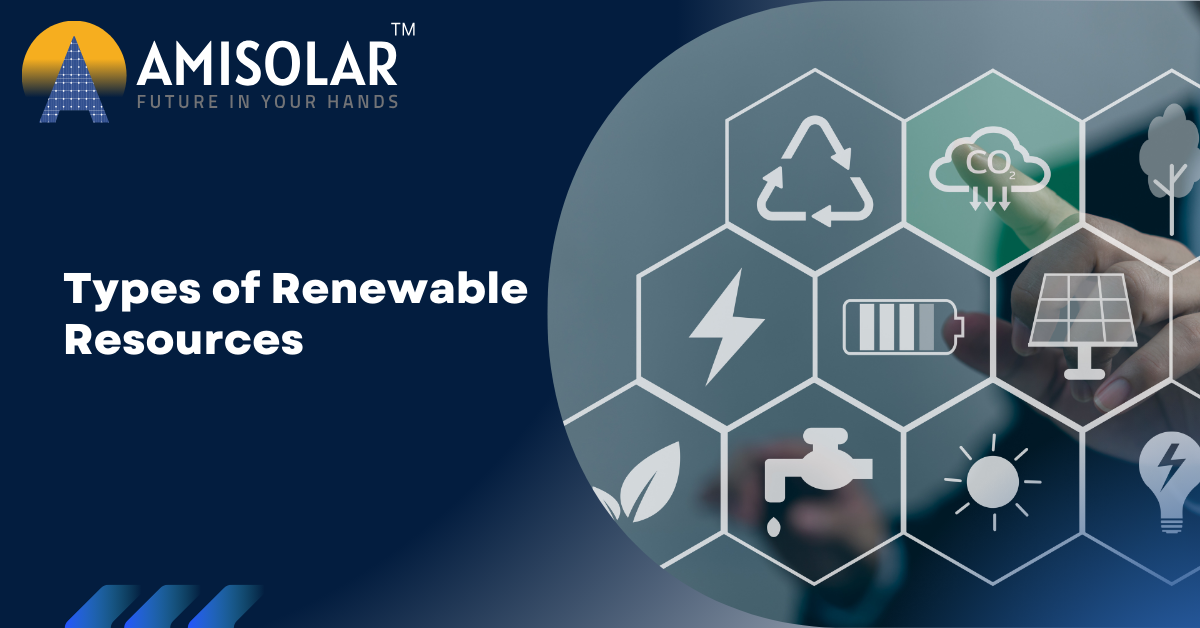As energy prices rise and concerns over the environment grow, many homeowners are turning to…

As the world continues to face environmental challenges and the depletion of fossil fuels, the need for sustainable and renewable energy sources has become more critical than ever. Renewable resources are energy sources that can be replenished naturally over time, making them sustainable alternatives to traditional fossil fuels. In this blog, we’ll explore the different types of renewable resources and their significance in promoting a sustainable future.
Solar Energy
Solar energy is harnessed from the sun’s radiation using photovoltaic (PV) cells or solar thermal systems. This energy can be used to generate electricity, heat water, and power various devices.
Advantages
- Abundant and widely available.
- Reduces electricity bills and dependence on grid power.
- Minimal environmental impact during operation.
- Low maintenance costs.
Applications
- Residential and commercial solar panels.
- Solar water heaters.
- Solar power plants.
- Solar-powered devices and gadgets.
Wind Energy
Wind energy is captured through wind turbines that convert the kinetic energy of wind into electricity. Wind farms can be located onshore or offshore.
Advantages
- Clean and emission-free energy source.
- High energy conversion efficiency.
- Can be installed in various locations with adequate wind speeds.
Applications
- Onshore and offshore wind farms.
- Small wind turbines for residential use.
- Wind-powered water pumps.
Hydropower
Hydropower, or hydroelectric power, is generated by harnessing the energy of flowing or falling water. Dams and rivers are commonly used to generate hydropower.
Advantages
- Reliable and consistent power generation.
- Long lifespan of hydroelectric plants.
- Can provide large-scale power supply.
Applications
- Large hydroelectric dams.
- Small hydro projects in rivers and streams.
- Pumped-storage hydropower plants.
Biomass Energy
Biomass energy is derived from organic materials such as wood, agricultural residues, and animal waste. These materials can be burned directly for heat or converted into biofuels.
Advantages
- Reduces waste and promotes recycling.
- Can be produced locally, supporting rural economies.
- Low carbon emissions when managed sustainably.
Applications
- Biomass power plants.
- Biofuels for transportation (e.g., biodiesel, ethanol).
- Residential heating using wood pellets.
Geothermal Energy
Geothermal energy is harnessed from the Earth’s internal heat. This energy is accessed by drilling wells to tap into hot water and steam reservoirs underground.
Advantages
- Provides a constant and reliable energy supply.
- Low emissions and minimal land footprint.
- Can be used for heating and cooling in addition to electricity generation.
Applications
- Geothermal power plants.
- Geothermal heat pumps for residential and commercial heating/cooling.
- Industrial processes require heat.
Ocean Energy
Ocean energy encompasses various technologies that harness the power of ocean waves, tides, and temperature differences to generate electricity.
Advantages
- Vast and untapped energy potential.
- Predictable energy generation from tidal movements.
- Minimal visual and noise pollution.
Applications
- Tidal power plants.
- Wave energy converters.
- Ocean thermal energy conversion (OTEC) systems.
The Importance of Renewable Resources
Renewable resources are crucial for several reasons:
Environmental Benefits: Renewable energy sources produce little to no greenhouse gas emissions, reducing air pollution and mitigating climate change.
Energy Security: By diversifying energy sources, countries can reduce their dependence on imported fossil fuels and enhance energy security.
Economic Growth: The renewable energy sector creates jobs, stimulates investment, and promotes sustainable economic development.
Resource Sustainability: Unlike fossil fuels, renewable resources are naturally replenished, ensuring a continuous supply of energy for future generations.
Conclusion
Transitioning to renewable energy sources is essential for creating a sustainable and resilient energy future. Solar, wind, hydropower, biomass, geothermal, and ocean energy each offer unique advantages and applications, contributing to a diversified and environmentally friendly energy mix. By embracing these renewable resources, we can reduce our carbon footprint, enhance energy security, and pave the way for a cleaner, greener world.


